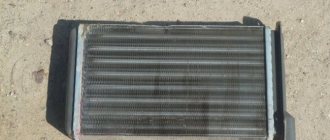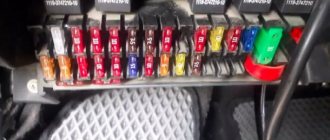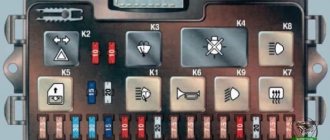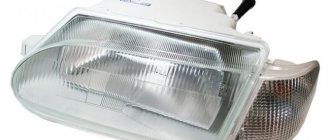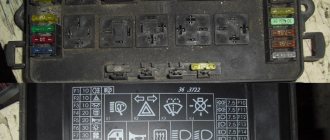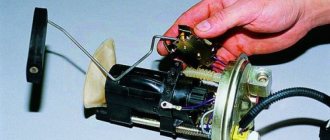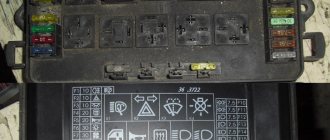Hello. Share a diagram of the parts and devices located under the hood.
- How to glue the hood reinforcement on a VAZ 2115? – 3 answers
- The amplifier has come off the hood of a VAZ 2115 - 3 answers
- Snow gets under the hood of a VAZ 2114 – 2 answers
- VAZ 2114 fuse diagram – 1 answer
- Icons on the instrument panel of the VAZ 2114 – 1 answer
In the center there is a motor, into which air flows through the receiver from the air filter, which is to the right of the engine. To the left of the engine is the windshield washer reservoir. The brake system hydraulic reservoir is located near the air duct above the air filter. The battery is in the lower right corner. The engine cooling system tank is installed slightly higher. The gearbox is located under the engine, under the right side.
Subscribe
to our channel in
Index.Zen
Even more useful tips in a convenient format
For the efficient operation of the injection power unit, the VAZ-2114 car system includes a large number of different mechanisms and automated devices. You can’t say that the “fourteenth” car is filled to capacity with electronics, but if you look under the hood, you can find all kinds of VAZ-2114 8-valve injector sensors.
The main purpose of electronics is to monitor the condition of vehicle components and assemblies. The received data is transmitted to the main “brain” center of the car. Thanks to this approach, the driver no longer needs to spend a long and exhausting time looking for reasons for deviations from the operation of a particular system. The ECU will provide all the information. What sensors are involved in the operation of the VAZ-2114 and where are they located?
General information about VAZ-2114 sensors
Sensors look like small mechanisms. However, their role in the operation of the entire vehicle system is simply colossal. They signal the remaining fuel in the gas tank, inform the driver of the coolant temperature, and determine the position of various engine elements in a certain operating mode. In order to know your car well and understand what could fail in a given situation, you need to know the entire list of mechanisms involved in the system.
We list all the sensors on the VAZ-2114 injector 8 valves, which are the most important:
- Crankshaft positions.
- TPDZ.
- Camshaft position sensor.
- DTOZH.
- Speed.
- Idle move.
- DMRV.
- Lambda probe.
These devices are in most cases located in the engine compartment. Almost all of them are installed at the factory during vehicle assembly. But the driver himself can install some sensors at any suitable time. It is also important to know how each of these devices works and what primary task it performs.
How to insulate yourself
Motorists insulate the car hood with their own hands.
Independent arrangement includes the following stages of work:
Preparation. First, you will need to dismantle the standard hood sound insulation (if available). The operation should be carried out carefully, trying not to damage it. Afterwards, the working surface is thoroughly washed and degreased. Creating templates. You need to make a pattern for the insulation. For these purposes, use old wallpaper or newspapers. It is necessary to carefully cut out the templates, according to which the insulation elements for the hood will subsequently be cut out. The remaining thermal insulation is cut into small strips, which will subsequently be attached to the stiffeners of the body element. Installation of insulation. When performing this operation, you need to stock up on a small roller, glue and insulation. If work is carried out in an insufficiently heated room, use a hair dryer. The adhesive is evenly applied to the degreased working surface, then the insulation is carefully applied from the corner and gradually fixed to the hood (if you stick the element right away, folds and air bubbles may appear). Afterwards, carefully roll over the glued insulation.
Care must be taken as bulges and dents may appear on the outside of the hood due to excessive pressure on the inside of the body element.
When the cold weather ends, the thermal insulation is dismantled. Before new use, the insulation is repaired and reinstalled on the car.
To quickly warm up the car in low temperatures, you need to use thermal insulation of the vehicle's engine compartment. First of all, the warm-up time is reduced, and as a result, fuel consumption is reduced
The engine cools down more slowly, which is important for motorists who use their cars intensively with short stops. For maximum efficiency, not only the hood, but also the air ducts along with the radiator grille are insulated
Crankshaft position sensor
You can often hear drivers with many years of experience calling this mechanism nothing other than a synchronization sensor. This name comes from the principle of operation of the device. The tasks of the DPKV are to synchronize the operation of the electronic unit and the gas distribution mechanism.
The VAZ-2114 is equipped with an inductive type DPKV. The cost of such a sensor is relatively small. If a vital controller for a car fails, most drivers prefer to immediately replace the device with a new one.
If the DPKV breaks down, further operation of the vehicle will become impossible. Without this mechanism, the fuel supply system will stop working, because the ECU will not receive information about when it is necessary to give a command to inject fuel into the cylinders. The location of the DPKV is in close proximity to the camshaft.
Electronics are responsible for fuel delivery in the VAZ-2114 car system. Without TPS, the control unit will not be able to determine the optimal time to supply gasoline. Deviations from the correct operation of the TPS lead to an increase in the amount of fuel consumed. The operation of many other car systems depends on the angle at which the remote control is located: cooling, fuel supply.
see also
The TPS is located near the idle speed sensor. In the “fourteenth” system, the work of these two devices is closely linked.
When the TPS breaks down, the car begins to twitch in a certain position of the damper, and instability of engine operation is also noted. All VAZ-2114 8 valve sensors are interconnected in their operation, so two different devices sometimes exhibit the same symptoms of malfunction. If symptoms of a breakdown occur, it is necessary to take a comprehensive approach to checking all controllers.
Metallic scraping noise when braking
Bandit cars of the 90s: list. popular cars of the 90s
We have already written about this above, but we should consider squeaking brakes in a little more detail. Brakes sometimes create a characteristic squeaking sound, especially if the pads are wet. Some types of brake pads (especially semi-metallic pads) can squeal or squeal even when they cool down during the winter season. If you hear metallic scraping noises when braking, like someone running a file over rough metal, your brake pads are worn out and your car needs brake service. You shouldn’t hesitate to do this and here’s why.
Worn brake pad
At low speeds, worn brakes work just as effectively, the only difference is an annoying sound. However, at medium and high speeds (50 km/h and above), such brakes may not work at all. In fact, if brakes that are badly worn are "switched on" at speed, there is a risk that the friction material left on the pads will separate from the backing plate. This will cause the brakes to fail and, pressing the pedal, the car will continue to move.
Camshaft position sensor
This mechanism is located near the cylinder block. The main task is to transmit data to the ECU regarding the current operating cycle. Among specialists, the mechanism is called a Hall sensor. The operation of the device is based on the following principle: in accordance with the location of the crankshaft, the position of the gas distribution mechanism is determined. The data received by the sensor is reported to the electronic unit. Fuel is injected and the mixture is subsequently ignited.
Knock sensor, DTOZH, speed and others
In addition to the above mechanisms, other very important devices can be found in various corners of the engine compartment. The location of the VAZ-2114 injector sensors is quite chaotic, some are located directly on the power unit, others in other places - the gearbox, on electrical circuits.
Some equally important mechanisms include:
- The knock sensor is sensitive to various engine vibrations. Based on the received pulses, the ECU determines the qualitative composition of the mixture. Located on the cylinder block.
Engine temperature sensor - the only and simple, but extremely important task assigned to this device is to monitor the coolant temperature.
Speed sensor – from the name itself it is clear that this controller is necessary to measure the speed of a car. The DS transmits impulses to the ECU, which processes them and determines the speed of the car; the resulting result is displayed on the instrument panel by the speedometer.
Idling speed – not only reads information, but also corrects engine operation. DXH, using a special needle, controls the pipe - closes and opens. Due to this, the amount of oxygen supplied to the throttle assembly changes.
Mass air flow sensor - reads the data and transmits it to the control unit, which, based on the information received, determines the optimal ratio of the various components of the fuel-air mixture. A breakdown of the air flow sensor leads to the fact that the car significantly loses power, and the driver begins to feel a significant increase in the amount of gasoline consumed by the car.
Sanding chips before painting
If you decide not to remove all the old paint, but only to update the hood, you need to very carefully remove and treat the places where the stones are chipped.
There are always a lot of them on the hood, because this is one of the most vulnerable places of the car. The chipping area must be covered with masking tape. And only after this the treatment is carried out: washed, dried and treated with a degreasing liquid. After this, we clean the edges of the chips with coarse sandpaper and remove the rust. Then you should clean the chipped area with a brush, rinse thoroughly and treat again with a degreaser.
If the scratch is deep, then it must be puttied. You can use regular aluminum putty. After drying, the treated area is sanded. Application of primer is not necessary when using this putty.
Before painting, we matte the entire remaining part of the hood (rubbing off the glossy layer). And after that we move on to the standard painting procedure, which is described below.
Car modifications 2114
VAZ-21140 . Modification with an 8-valve injection engine VAZ-2111, 1.5 liters and 77 horsepower. Serial production from 2003 to 2007
VAZ-21144 . Modification with an 8-valve VAZ-21114 engine, 1.6 liters and 81.6 horsepower. Years of serial production: 2007-2013.
VAZ-211440 . Another modification released in 2007, it was equipped with a VAZ-11183 engine with a volume of 1.6 liters and a power of 82 horsepower. The car was discontinued in 2013.
VAZ-211440-24 . Released in 2009, a modification with an injection 16-valve VAZ-21124 engine with a volume of 1.6 liters and a power of 89.1 horsepower. Discontinued in 2013.
VAZ-211440-26 . Modification with a 16-valve injection engine VAZ-21126, which complies with the Euro-3 environmental standard, with a volume of 1.6 liters and a power of 98 hp. The car was produced from 2010 to 2013.
Repair manual for VAZ 2110, 2112, 2111 (Lada 110)
1.1. Overall dimensions of the VAZ-2110 car
1.2. Overall dimensions of the VAZ-2111 car
1.3. Overall dimensions of the VAZ-2112 car
Small class cars VAZ-2110 (export name Lada 110) with a four-door five-seater sedan body (class C according to the international classification) are equipped with engines of 1.5 and 1.6 liters, with a power of 58–68 kW (79–92.5 hp). c.), located across the engine compartment.
Previously, cars at the factory were equipped with 1.5 liter engines: first with carburetor engines, and then with a distributed fuel injection system. Currently, cars are equipped only with engines with a displacement of 1.6 liters: eight-valve VAZ-21114 and sixteen-valve VAZ-21124 with distributed fuel injection systems and three-component exhaust gas catalysts with feedback. The engines meet Euro-2 and Euro-3 standards.
The body is load-bearing, all-metal, of welded construction with hinged doors, front fenders, hood and trunk lid. The VAZ-2110 car is the first sedan in Russia with a hatch that can be opened from the trunk leading into the cabin, which allows you to transport long items.
Part of the production modification 21103 with a 16-valve VAZ-2112 engine is equipped with air conditioning, and since the end of 2002, on request, power steering from ZF.
This modification differs from the basic one by a hood with an integrated radiator lining of a more modern shape and a front bumper, as well as original headlights. The rear lights, moldings and interior details have also been changed.
In 1998, production of the VAZ-2111 car (export name Lada 111) with a station wagon body began. According to the layout, engine, transmission, chassis, body equipment, this car is identical to the VAZ-2110 car. It features a redesigned rear end with a large tailgate. The trunk of this car is the most spacious in the family: 490 liters with the rear row of seats raised and 1420 liters with them folded.
Production of the VAZ-2112 car (export name Lada 112) with a hatchback body began in 2000. The layout of this car is the same as that of the VAZ-2111, but the body has a large rear angle. The engines are used only with a distributed injection system, both 8-valve and 16-valve. The rear seat folds in a 2:3 ratio, which increases trunk capacity from 415 to 1270 liters. The interior, like other models of the family, is equipped in “standard”, “norm” and “luxury” trim levels. The latest equipment includes fog lights, headlight cleaner and washer, 14-inch alloy wheels, three-way catalytic converter (Euro 2), internal bonnet lining, door security bars, immobilizer, on-board monitoring system, velvet seat upholstery and soft upholstery doors, central electric door locking, electric windows. By additional order, an on-board computer, electric front seat heaters, electric outside rear-view mirrors, anti-lock brakes, an airbag and a sunroof are installed.
1.4. Layout diagram of the VAZ-2111 car: 1 – engine; 2 – spare wheel; 3 – muffler; 4 – rear suspension strut; 5 – drum brake; 6 – rear suspension beam; 7 – fuel tank; 8 – resonator; 9 – disc brake; 10 – shock absorber strut; 11 – steering mechanism
The layout diagram of all three cars is almost the same, so it is shown using the example of a VAZ-2111 car in Fig. 1.4.
1.5. Engine compartment of cars with engine mod. 2111 (top view): 1 – engine; 2 – adsorber for the gasoline vapor recovery system; 3 – receiver; 4 – brake master cylinder; 5 – expansion tank; 6 – washer reservoir; 7 – battery; 8 – air filter; 9 – ignition module
1.6. The engine compartment of all cars is from below (engine protection removed): 1 – engine; 2 – starter; 3 – front suspension cross member; 4 – gearbox; 5 – stretching; 6 – exhaust pipe; 7 – anti-roll bar; 8 – front suspension arm; 9 – wheel drive; 10 – engine oil sump; 11 – generator
Wiring diagram VAZ-2114 for old models
Electrical diagram of car 2114: 1 - headlight; 2 [Installed on a part of the car] - fog lamp; 3 — ambient air temperature sensor; 4 — electric engine radiator fan; 5 — block for connection to the wiring harness of the engine control system; 6 — engine compartment lamp switch; 7 [Installed on a part of the car] - reserve block for connecting an audio signal with one terminal (the negative terminal is connected to the body); 8 — sound signal; 9 — liquid level sensor in the windshield washer reservoir; 10 [Installed on a part of the car] - brake pad wear sensor; 11 — low oil level sensor; 12 - generator; 13 [Installed on a part of the car] - engine compartment lamp; 14 — temperature indicator sensor; 15 — starter; 16 — battery; 17 [Installed on a part of the car] - relay for turning on fog lights; 18 — coolant level sensor in the expansion tank; 19 — sensor of insufficient brake fluid level; 20 — reversing light switch; 21 — windshield wiper gear motor; 22 — emergency oil pressure sensor; 23 — rear window washer electric pump; 24 — electric pump for windshield washer; 25 — instrument panel; 26 — mounting block of fuses and relays; 27 — brake signal switch; 28 — ignition relay; 29 - ignition switch (lock); 30 — glove box lighting lamp; 31 — switch for the glove compartment lighting lamp; 32 — rear window heating switch; 33 — rear fog light switch; 34 [Installed on a part of the car] - fog light switch; 35 - combined switch for side lights and headlights; 36 — alarm switch; 37 — steering column switches; 38 — brightness control for instrument lighting; 39 — illumination lamp for the headlight hydraulic adjustment control handle; 40 — socket for connecting a portable lamp; 41 — side direction indicator; 42 — interior lighting switch (front door open sensor); 43 — interior lamp; 44 — electric fan of the ventilation and heating system; 45 — additional resistor of the electric fan of the ventilation and heating system; 46 — switch for operating modes of the electric fan of the ventilation and heating system; 47 — illumination lamp for the handle of the operating mode switch of the electric fan of the ventilation and heating system; 48 — backlight lamp for the heater control unit; 49 — display unit of the on-board control system; 50 [Installed on part of the car] - trip computer; 51 — interior lighting switch (rear door open sensor); 52 [Installed on a part of the car] - block for connecting a clock; 53 — fuel module; 54 — ashtray illumination lamp; 55 — cigarette lighter; 56 — interior lamp; 57 — switch for the parking brake warning lamp; 58 — rear light; 59 — license plate light; 60 — additional brake light; 61 — heating element for heating the rear window; 62 — rear window wiper gear motor; A - numbers of pins in connecting blocks.
Description of the engine compartment of VAZ cars of the tenth family
All descriptions are presented in the form of drawings, from which the main components and parts of the VAZ 2110
.
Rice. 1.4. Engine compartment
of cars with engine mod. 2111 (top view): 1 - engine; 2 — adsorber of the gasoline vapor recovery system; 3- receiver; 4- brake master cylinder; 5- expansion tank; 6 — washer reservoir; 7 - battery; 8- air filter; 9-ignition module
Rice. 1.5. The engine compartment of all cars is from below (engine protection removed): 1 - engine; 2 - starter; 3 — cross member of the front suspension; 4 — gearbox; 5 - stretching; 6 — exhaust pipe; 7 — anti-roll bar; 8 — front suspension arm; 9 — wheel drive; 10 — engine oil sump; 11 — generator Fig. 1.6. Engine compartment of cars with engine mod. 21124 (top view with the decorative cover removed): 1 - intake manifold with receiver; 2 — throttle assembly; 3 — brake master cylinder reservoir; 4 - expansion tank; 5 — washer reservoir; 6 — inlet pipe; 7 - battery; 8 — air filter; 9 — ignition coils; 10 — timing belt protective cover; 11 - adsorber; 12 — tailgate glass washer reservoir (on cars with station wagon and hatchback bodies) Fig. 1.7. Engine compartment of cars with engine mod. 2112 (top view): 1 - engine; 2 — adsorber of the gasoline vapor recovery system; 3 - receiver; 4 — brake master cylinder; 5 - expansion tank; 6 — washer reservoir; 7 - battery Fig. 1.8. Engine compartment of cars with engine mod. 21083-80 or 2110 (top view): 1 - engine; 2 — air filter: 3 — fuel pump; 4 — brake master cylinder; 5 - expansion tank; 6 — washer reservoir; 7 - battery; 8 — ignition distributor
If you liked it?! Share with a friend or girlfriend or a plus from the heart. Thank you so much, friends. (Social networks connected in August 2013)
Your reviews, comments, questions and answers on LADA-10.ru
Everyone is welcome to participate in the discussion about the causes of the malfunction and other problems. If you know what to answer, write and thereby help other VAZ 2110 owners in searching for the truth.
Comments on the LADA-10.ru website were launched on January 11, 2012
Source
VAZ-2114 diagram (second option)
Electrical diagram of VAZ-2114 cars (without engine control system):
1 — block headlights; 2 — fog lights; 3 — air temperature sensor; 4 — electric motor of the engine cooling system fan; 5 — blocks connected to the wiring harness of the ignition system; 6 — engine compartment lamp switch; 7 — block for connecting to a single-wire type audio signal; 8 — sound signal; 9 — washer fluid level sensor; 10 — front brake pad wear sensor; 11 — oil level sensor; 12 - generator; 13 — engine compartment lamp; 14 — coolant temperature indicator sensor; 15 — starter; 16 - battery; 17 — relay for turning on fog lights; 18 — coolant level sensor; 19 — brake fluid level sensor; 20 — reverse light switch; 21 — windshield wiper gearmotor; 22 — oil pressure warning lamp sensor; 23 — block for connecting to the rear window washer electric motor; 24 — electric motor for windshield washer; 25 — instrument cluster; 26 — mounting block 2114; 27 — brake light switch; 28 — ignition relay; 29 — ignition switch; 30 — glove box lighting lamp; 31 — glove box lighting switch; 32 — rear window heating element switch; 33 — rear fog light switch; 34 — fog lamp switch; 35 — switch for external lighting lamps; 36 — alarm switch; 37 — steering column switches; 38 — switch for instrument lighting lamps; 39 — lamp for illuminating the headlight hydrocorrector scale; 40 — plug socket for a portable lamp; 41 — side direction indicators; 42 — lamp switch on the front door pillars; 43 — lamp for individual interior lighting; 44 — heater fan electric motor; 45 — additional resistor of the heater electric motor; 46 — heater fan switch; 47 — heater switch illumination lamp; 48 — lamp for illuminating the heater levers; 49 — on-board control system unit; 50 — trip computer; 51 — lamp switch on the rear door pillars; 52 — block for connecting the wiring harness of the engine control system; 53 — electric fuel pump and gasoline quantity sensor; 54 — front ashtray illumination lamp; 55 — cigarette lighter 2114; 56 — trunk lighting lamp; 57 — trunk light switch; 58 — interior lamp; 59 — parking brake warning lamp switch; 60 — rear external lights; 61 — rear internal lights; 62 — block for connection to the rear window heating element; 63 — license plate lights; 64 - additional brake signal located in the spoiler.
Conventional numbering of plugs in blocks:
Wiring diagram VAZ-2114 new models
The updated engine has a new injection scheme, so it was necessary to use some new devices, as well as replace the ignition coil with a more efficient one and adapted to Euro 3 conditions. In order to comply with them, the engine had to minimize the amount of CO at start-up. And for this it was necessary to lean the mixture. Since a lean mixture ignites worse, it needed a more powerful spark to spark. This explains the use of a coil of increased power.
- block headlights;
- gearmotors for headlight cleaners*;
- fog lights*;
- ambient temperature sensor;
- sound signals;
- engine compartment light switch;
- engine cooling fan electric motor;
- generator VAZ-2114;
- low oil level indicator sensor;
- washer fluid level sensor;
- front brake pad wear sensor;
- wire ends connected to the common windshield washer pump**;
- windshield washer pump;
- headlight washer pump*;
- wire ends for connecting to the rear window washer pump on VAZ-2113 and VAZ-2114 cars;
- low oil pressure indicator sensor;
- engine compartment lamp;
- wire lug for connecting to the engine management system wiring harness;
- windshield wiper gear motor;
- starter VAZ-2114;
- block connected to the wiring harness of the ignition system on carburetor cars;
- coolant temperature indicator sensor;
- reverse light switch;
- low brake fluid level indicator sensor;
- accumulator battery;
- low coolant level indicator sensor;
- relay for turning on fog lights;
- mounting block;
- brake light switch;
- plug socket for a portable lamp;
- hydrocorrector scale illumination lamp;
- parking brake indicator lamp switch;
- block for connecting a backlight lamp;
- switch for instrument lighting lamps;
- Understeering's shifter;
- hazard switch;
- front seat heating element relay;
- ignition switch;
- rear fog lamp circuit fuse;
- front seat heating elements circuit fuse;
- door lock circuit fuse;
- front ashtray illumination lamp;
- ignition relay;
- cigarette lighter VAZ-2114;
- glove box lighting lamp;
- glove compartment light switch;
- heater fan motor;
- additional heater motor resistor;
- heater fan switch;
- heater switch illumination lamp;
- heater lever illumination lamp;
- gear motors for electric windows of the front doors;
- right front door ESP switch (located in the right door);
- gear motors for locking front door locks;
- wires for connecting to the right front speaker;
- gear motors for locking rear doors;
- wires for connecting to the right rear speaker;
- door lock control unit;
- wires for connecting to radio equipment;
- headlight wiper switch*;
- rear window heating element switch;
- rear fog light relay;
- block for connection to the heating element of the right front seat;
- rear fog light switch;
- right front seat heating element switch;
- fog light switch*;
- switch for external lighting lamps;
- left front seat heating element switch;
- block for connection to the heating element of the left front seat;
- wires for connecting to the left front speaker;
- left front door power window switch (located in the left door);
- right front door power window switch (located in the left door);
- wires for connecting to the left rear speaker;
- side direction indicators;
- dome light switches on the front door pillars;
- dome light switches on the rear door pillars;
- lampshade VAZ 2114;
- individual interior lighting lamp;
- block for connecting to the wiring harness of the electric fuel pump;
- trunk light switch;
- instrument cluster;
- trunk light;
- on-board control system display unit;
- trip computer*;
- block for connecting the wiring harness of the engine management system;
- rear exterior lights;
- rear interior lights;
- pads for connecting to the rear window heating element;
- license plate lights;
- additional brake signal located on the spoiler.
Relays and fuses VAZ 2114
F1 for 10 Amps (A) rear fog lights and rear fog light warning lamp. F2 for 10 A turn signal lamps, turn signal relay, hazard lights, hazard warning lights. F3 7.5 A lamps for interior lighting (both) and trunk, ignition lighting, powertrain control system control lamp, brake lamps, computer, if available. F4 20 A carrier, relay and rear window heating element. F5 20 A horn and its relay, cooling fan. F6 30 A power windows and their relays F7 30 A motor heater, headlight cleaner, windshield washer, cigarette lighter, glove compartment light bulb, rear window heating relay winding. F8 7.5 A right fog lamp. F9 7.5 A left fog lamp. F10 at 7.5 A left side marker, lamp signaling the inclusion of the side light, lamps for illuminating the sign, engine compartment, illumination of switches and instruments, instrument lighting switch. F11 at 7.5 A right side. F12 at 7.5 A right low beam. F13 at 7.5 A left low beam. F14 for 7.5 A left high beam and a light indicating that the high beam headlights are on. F15 at 7.5 A right far. F16 30 A - a light indicating insufficient oil pressure, brake fluid level, engagement of the parking brake, low battery, instrument cluster, relay for monitoring the health of lamps, indication of control systems, reversing lamps, turn indicators and their relays, as well as an alarm if turning mode is turned on, computer, generator excitation winding is turned on at the moment the engine starts.
